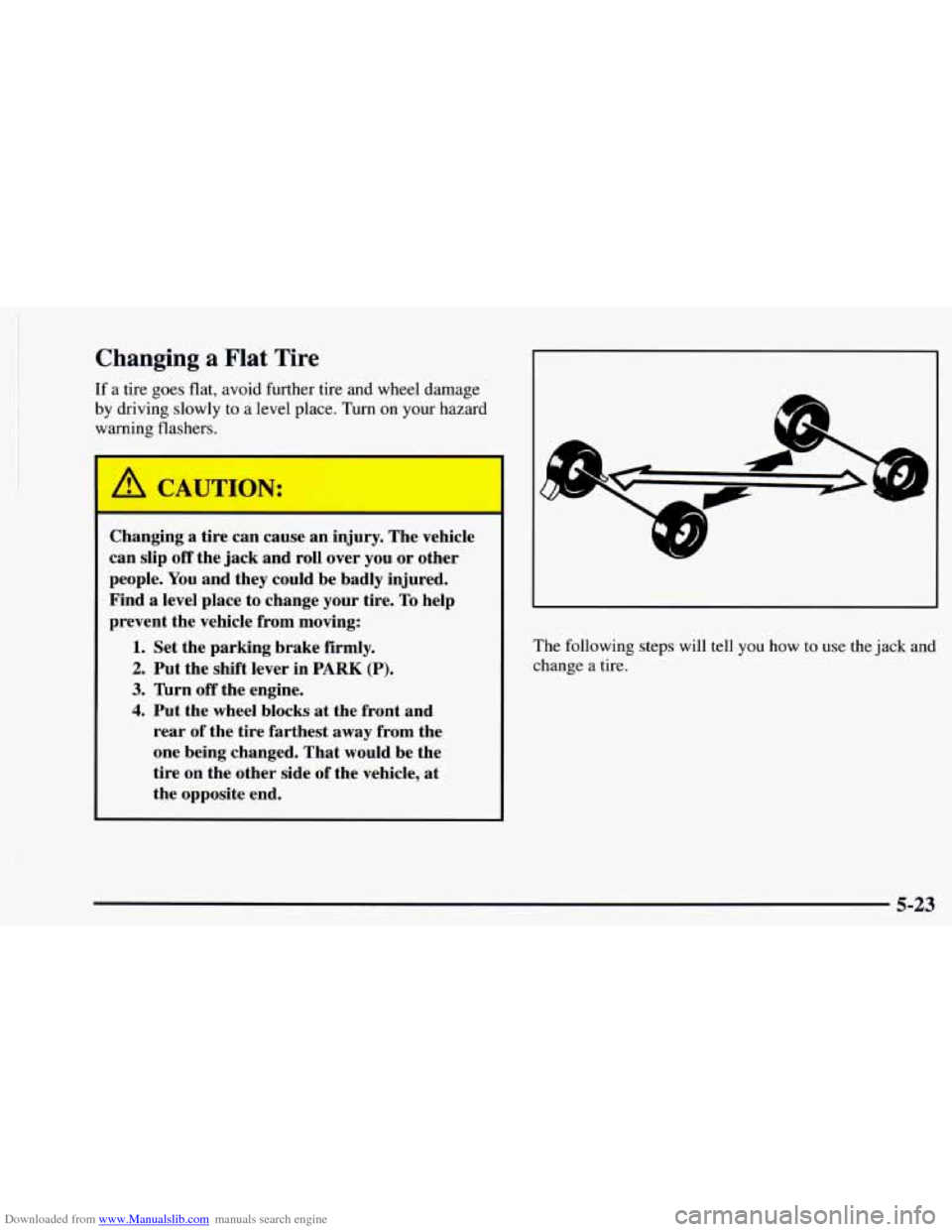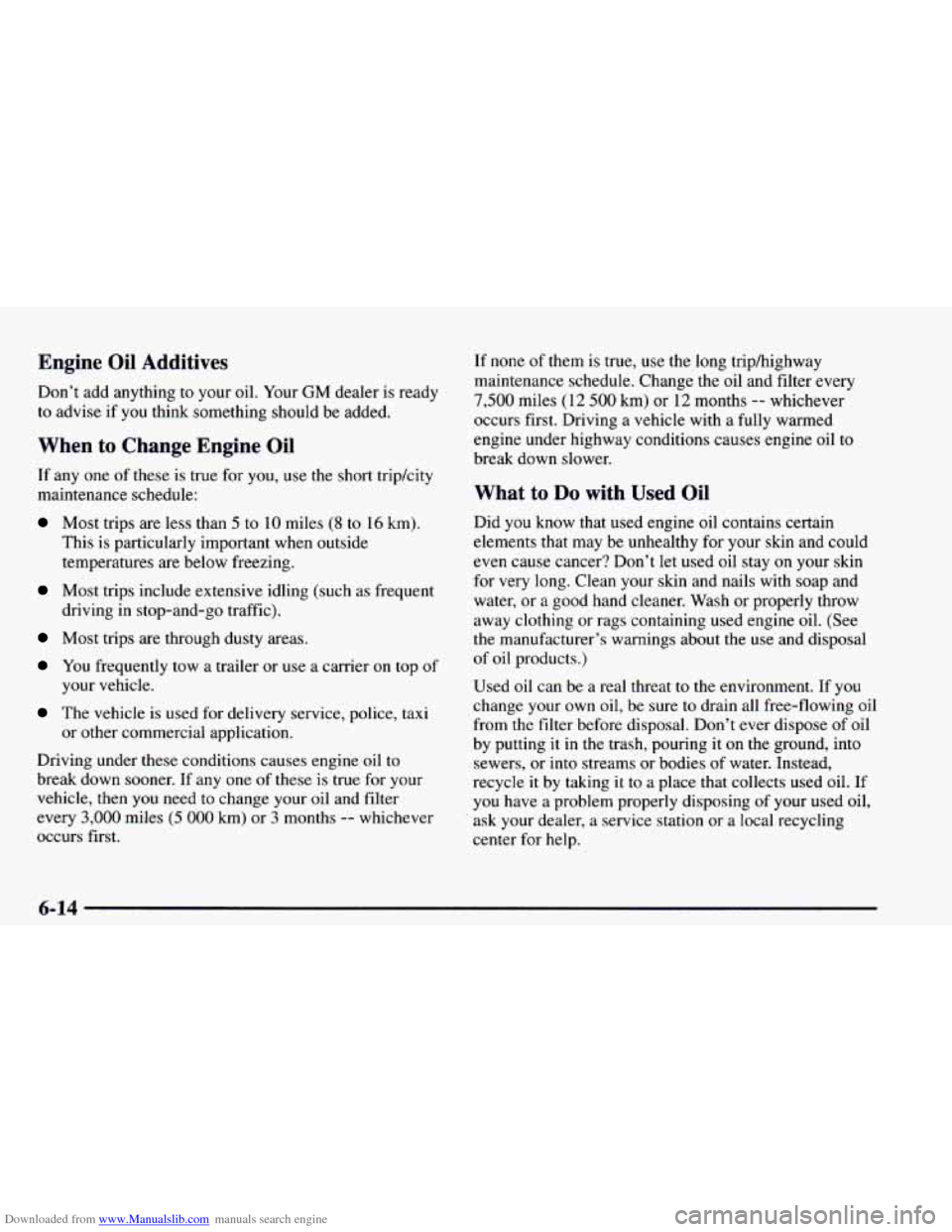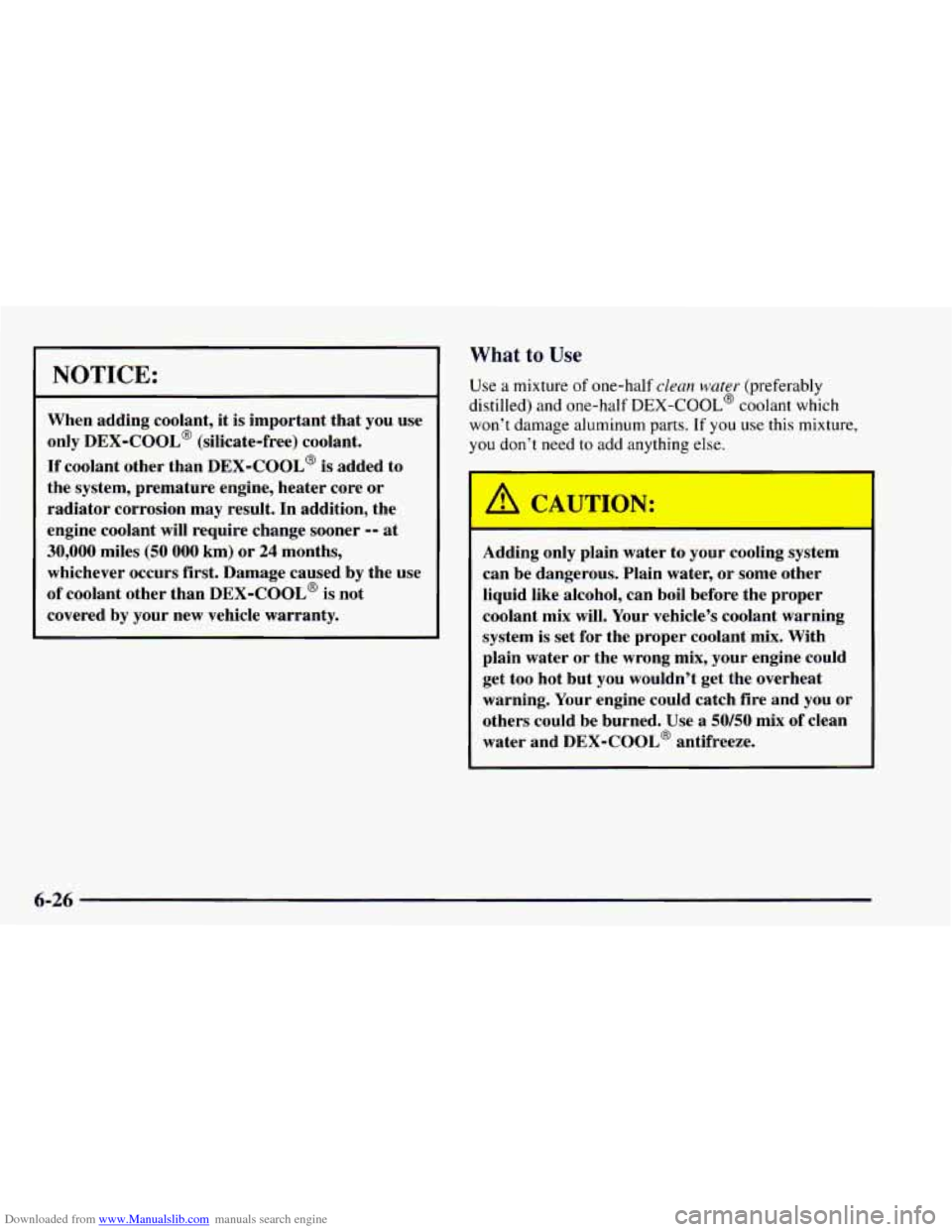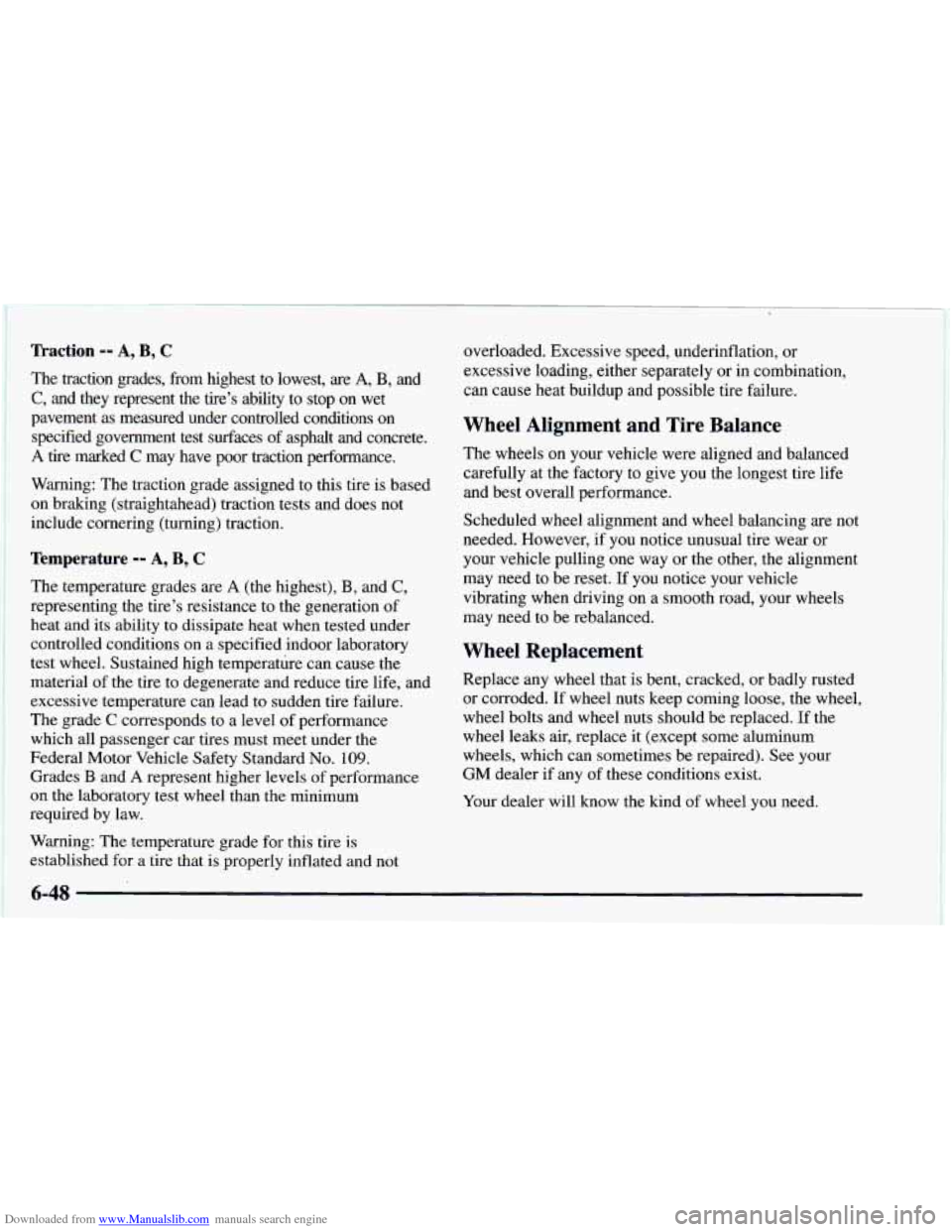1997 CHEVROLET ASTRO warning
[x] Cancel search: warningPage 241 of 404

Downloaded from www.Manualslib.com manuals search engine Changing a Flat Tire
If a tire goes flat, avoid further tire and wheel damage
by driving slowly to
a level place. Turn on your hazard
warning flashers.
I A CAUTION:
I
Changing a tire can cause an injury. The vehicle
can slip
off the jack and roll over you or other
people.
You and they could be badly injured.
Find
a level place to change your tire. To help
prevent the vehicle from moving:
1. Set the parking brake firmly.
2. Put the shift lever in PARK (P).
3. 'hrn off the engine.
4. Put the wheel blocks at the front and
rear of the tire farthest away from the
one being changed. That would be the
tire on the other side of the vehicle, at
the opposite end.
The following steps will tell you how to use the jack and
change
a tire.
5-23
Page 270 of 404

Downloaded from www.Manualslib.com manuals search engine Engine Oil Additives
Don’t add anything to your oil. Your GM dealer is ready
to advise if you think something should be added.
When to Change Engine Oil
If any one of these is true for you, use the short tripkity
maintenance schedule:
Most trips are less than 5 to 10 miles (8 to 16 km).
This is particularly important when outside
temperatures are below freezing.
Most trips include extensive idling (such as frequent
driving in stop-and-go traffic).
Most trips are through dusty areas.
You frequently tow a trailer or use a carrier on top of
your vehicle.
The vehicle is used for delivery service, police, taxi
or other commercial application.
Driving under these conditions causes engine oil
to
break down sooner. If any one of these is true for your
vehicle, then you need to change your oil and filter
every
3,000 miles (5 000 km) or 3 months -- whichever
occurs first. If
none
of them is true, use the long triphighway
maintenance schedule. Change the oil and filter every
7,500 miles (12 500 km) or 12 months -- whichever
occurs first. Driving a vehicle with a
fully warmed
engine under highway conditions causes engine
oil to
break down slower.
What to Do with Used Oil
Did you know that used engine oil contains certain
elements that may be unhealthy for your skin and could
even cause cancer? Don’t let used oil stay
on your skin
for very long. Clean your skin and nails with soap and
water,
or a good hand cleaner. Wash or properly throw
away clothing or rags containing used engine oil. (See
the manufacturer’s warnings about the use and disposal
of oil products.)
Used oil can be a real threat
to the environment. If you
change your own oil, be sure to drain all free-flowing oil
from the filter before disposal. Don’t ever dispose of oil
by putting
it in the trash, pouring it on the ground, into
sewers,
or into streams or bodies of water. Instead,
recycle
it by taking it to a place that collects used oil. If
you have a problem properly disposing of your used oil,
ask your dealer, a service station or a local recycling
center for help.
6-14
Page 281 of 404

Downloaded from www.Manualslib.com manuals search engine Rear Axle What to Use .
When to Check and Change Lubricant
Refer to the Maintenance Schedule to determine how
often
to check the lubricant and when to change it. See
“Scheduled Maintenance Services” in the Index.
How to Check Lubricant
If the level is below the bottom of the filler plug hole,
you’ll need
to add some lubricant. Add enough lubricant
to raise
the level to the bottom of the filler plug hole. Refer to the Maintenance Schedule to
determine what
kind of lubricant to use. See “Recommended Fluids and
Lubricants”
in the Index.
Engine Coolant
The cooling s stem in your vehicle is filled with new
DEX-COOL
J engine coolant. This coolant is designed
to remain in your vehicle for 5 years or 150,000 miles
(240 000 km) whichever occurs first, if you add only
DEX-COOL’ extended life coolant.
The following explains your cooling system and how to
add coolant when
it is low. If you have a problem with
engine overheating, see “Engine Overheating”
in
the Index.
A 50/50 mixture of water and DEX-COOL@ coolant for
your vehicle
will:
Give freezing protection down to -34°F (-37°C).
Give boiling protection up to 265°F (129°C).
Protect against rust and corrosion.
Help keep the proper engine temperature.
0 Let the warning lights and gages work as they should.
6-25
Page 282 of 404

Downloaded from www.Manualslib.com manuals search engine I
NOTICE:
When adding coolant, it is important that you use
only
DEX-COOL’ (silicate-free) coolant.
If coolant other than DEX-COOL’ is added to
the system, premature engine, heater core or radiator corrosion may result. In addition, the
engine coolant will require change sooner
-- at
30,000 miles (50 000 km) or 24 months,
whichever occurs first. Damage caused by the
use
of coolant other than DEX-COOL@ is not
covered by your new vehicle warranty.
What to Use
Use a mixture of one-half clean wuter (preferably
distilled) and one-half
DEX-COOL@ coolant which
won’t damage aluminum parts.
If you use this mixture,
you don’t need to add anything else.
Adding only plain water to your cooling system
can be dangerous. Plain water, or some other
liquid like alcohol, can boil before the proper
coolant mix will, Your vehicle’s coolant warning
system is set for the proper coolant mix. With
plain water or the wrong mix, your engine could
get too hot but you wouldn’t get the overheat
warning. Your engine could catch fire and you or
others could be burned, Use a
50/50 mix of clean
water and DEX-COOL@ antifreeze.
6-26
Page 290 of 404

Downloaded from www.Manualslib.com manuals search engine go or be heard all the time your vehicle is moving (except
when
you are pushing on the brake pedal firmly). NOTICE:
0
0
Using the wrong fluid can badly damage
brake system parts. For example, just
a few
drops
of mineral-based oil, such as engine
oil, in your brake system can damage brake
system parts
so badly that they’ll have to be
replaced. Don’t let someone put in the
wrong kind of fluid.
If you spill brake fluid on your vehicle’s
painted surfaces, the paint finish can be
damaged. Be careful not to spill brake fluid
on your vehicle.
If you do, wash it off
immediately. See “Appearance Care” in
the Index.
Brake Wear
Your vehicle has front disc brakes and rear drum brakes.
Disc brake pads have built-in wear indicators that make a
high-pitched warning sound when the brake
pads are
worn and new pads are needed. The sound may come and
A CAUThN:
The brake wear warning sound means that soon
your brakes won’t work well. That could lead to
an accident. When you hear the brake wear
warning sound, have your vehicle serviced.
I NOTICE:
Continuing to drive with worn-out brake pads
could result in costly brake repair.
Some driving conditions
or climates may cause a brake
squeal when
the brakes are first applied or lightly
applied. This does not mean somethim
is wrong with
your brakes.
6-34
Page 304 of 404

Downloaded from www.Manualslib.com manuals search engine Traction -- A, B, C
The traction grades, from highest to lowest, are A, €3, and
C, and they represent the tire’s ability to stop on wet
pavement as measured under controlled conditions on
specified government test surfaces
of asphalt and concrete.
A tire marked C may have poor traction performance.
Warning: The traction grade assigned to this tire is based
on braking (straightahead) traction tests and does not
include cornering (turning) traction.
Temperature -- A, B, C
The temperature grades are A (the highest), B, and C,
representing the tire’s resistance to the generation of
heat and
its ability to dissipate heat when tested under
controlled conditions on a specified indoor laboratory
test wheel. Sustained high temperature can cause the
material of the tire to degenerate and reduce tire life, and
excessive temperature can lead to sudden tire failure.
The grade
C corresponds to a level of performance
which all passenger car tires must meet under the
Federal Motor Vehicle Safety Standard
No. 109.
Grades B and A represent higher levels of performance
on
the laboratory test wheel than the minimum
required by law.
Warning: The temperature grade for this tire is
established for a tire that is properly inflated and not overloaded.
Excessive speed, underinflation, or
excessive loading, either separately or in combination,
can cause heat buildup and possible tire failure.
Wheel Alignment and Tire Balance
The wheels on your vehicle were aligned and balanced
carefully at the factory to give you the longest tire life
and best overall performance.
Scheduled wheel alignment and wheel balancing are not
needed. However, if you notice unusual tire wear or
your vehicle pulling one way or the other, the alignment
may need to be reset. If you notice your vehicle
vibrating when driving
on a smooth road, your wheels
may need to be rebalanced.
Wheel Replacement
Replace any wheel that is bent, cracked, or badly rusted
or corroded. If wheel nuts keep coming loose, the wheel,
wheel bolts and wheel nuts should be replaced. If the
wheel leaks air, replace
it (except some aluminum
wheels, which can sometimes be repaired). See your
GM dealer if any
of these conditions exist.
Your dealer will know the kind of wheel you need.
6-48
Page 306 of 404

Downloaded from www.Manualslib.com manuals search engine Tire Chains Appearance Care
Remember, cleaning products can be hazardous. Some
are toxic. Others can burst
into flame if you strike a
match or get them on
a hot part of the vehicle. Some are
dangerous
if you breathe their fumes in a closed space.
When you use anything from
a container to clean your
vehicle, be sure to follow the manufacturer’s warnings
and instructions. And always open your doors
or
windows when you’re cleaning the inside.
Never use these to clean your vehicle:
NOTICE:
If your vehicle has P235/65R15 size tires, don’t
use tire chains. They can damage your vehicle
because there’s not enough clearance.
If you have other size tires, use tire chains only
where legal and only when you must. Use only
SAE Class “S” type chains that are the proper
size for your tires. Install them on the rear axle
tires and tighten them as tightly
as possible with
the ends securely fastened. Drive
slowly and
follow the chain manufacturer’s instructions. If
you can hear the chains contacting your vehicle,
stop and retighten them.
If the contact continues,
slow down until it stops. Driving
too fast or
spinning the wheels with chains on will damage
your vehicle.
0 Gasoline
Benzene
Naphtha
0 Carbon Tetrachloride
0 Acetone
a Paint Thinner
Turpentine
0 Lacquer Thinner
0 Nail Polish Remover
They can
all be hazardous -- some more than
others
-- and they can all damage your vehicle, too.
Page 391 of 404

Downloaded from www.Manualslib.com manuals search engine Section 9 Index
Accessory Power Outlet ......................... 2-52
Add-on Equipment
............................. 4-30
AirBag
....................................... 1-27
Adding Equipment
............................ 1-33
How Does
it Restrain .......................... 1-3 1
How it Works ................................ 1-29
Location
.................................... 1-29
Readiness Light
......................... 1.28. 2.61
Servicing
................................... 1-32
What Makes
it Intlate .......................... 1-30
What Will
You See After it Inflates ............... 1-3 I
When Should it Inflate ......................... 1-30
AirCleanerFilter
............................... 6-19
Air Conditioning Refrigerants
..................... 6-67
Alignment and Balance. Tire
...................... 6-48
All-Wheel Drive
.......................... 2.22. 6.23
Aluminum Wheels. Cleaning
...................... 6-57
Antenna. Fixed
................................. 3-30
Antifreeze
..................................... 6-25
Anti-Lock
Brakes
...................................... 4-7
Brake System Warning Light
................ 2.64. 4.7
Anti.Theft. Radio
.............................. 3-26
Appearance Care
............................... 6-50
Appearance Care Materials
....................... 6-59
Arbitration Program
.............................. 8-9
Ashtrays
...................................... 2-50
Air
Conditioning
................................ 3-5 Audio Equipment. Adding
........................ 3-28
Audio Systems
.................................. 3-9
Automatic Transmission Check
........................... 7-44
Transmission Fluid
............................ 6-20
Transmission Operation
........................ 2-19
Front
....................................... 6-24
LockingRear
................................ 2-22
Rear
....................................... 6-25
Battery
...................................... 6-36
Jump Starting
................................. 5-3
Replacement. Remote Keyless Entry
............... 2-9
Wdrnings
.................................... 5-3
BBB Auto Line
................................. 8-9
Better Business Bureau Mediation
................... 8-9
Brake
Adjustment
.................................. 6-35
Fluid
....................................... 6-32
Master Cylinder
.............................. 6-32
Parking
..................................... 2-23
PedalTravel
................................. 6-35
Replacing System Parts
........................ 6-35
System Warning Light
......................... 2-63
Trailer ...................................... 4-35
Transmission Shift Interlock Check
............... 7-45
Wear
....................................... 6-34
Axle
9-1